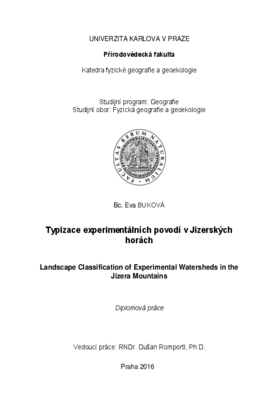Typizace experimentálních povodí v Jizerských horách
Landscape Classification of Experimental Watersheds in the Jizera Mountains
diploma thesis (DEFENDED)

View/
Permanent link
http://hdl.handle.net/20.500.11956/84872Identifiers
Study Information System: 161134
Collections
- Kvalifikační práce [20352]
Author
Advisor
Referee
Šobr, Miroslav
Faculty / Institute
Faculty of Science
Discipline
Physical Geography and Geoecology
Department
Department of Physical Geography and Geoecology
Date of defense
29. 5. 2017
Publisher
Univerzita Karlova, Přírodovědecká fakultaLanguage
Czech
Grade
Good
Keywords (Czech)
Typologie krajiny - změny krajinného pokryvu - srovnávací analýza povodíDiplomová práce se zabývá typologií krajiny experimentálních povodí ČHMÚ v Jizerských horách, která byla provedena na základě vybraných fyzicko-geografických charakteristik, jež mohou ovlivňovat jejich srážkoodtokové procesy. Vybranými faktory jsou geologické poměry, půdní pokryv, charakteristiky reliéfu - sklonitost a expozice a především vegetační poměry. Právě krajinný pokryv představuje jeden z nejvýznamnějších faktorů, které formují povrchový odtok. Pro typologii krajiny byla využita metoda klastrové (shlukové) analýzy, a to konkrétně metoda k - průměrů. Tato typologie byla provedena jak pro abiotické vlastnosti povodí, tak pro krajinný pokryv. Při tvorbě obou klasifikací bylo zhotoveno celkem 5 analýz o různém počtu shluků. Na základě těchto analýz byla vymezena povodí, která si jsou svými abiotickými vlastnostmi a krajinným pokryvem nejvíce podobná. Součástí práce je i hodnocení vývoje krajiny zájmového území za roky 1953,1986 a 2013.
The aim of the diploma thesis is to present the landscape classification of the Czech hydrometeorological institute's experimental Watersheds in the Jizera Mountains. The classification was developed on the Watersheds of selected physical- geographic characteristics that can influence its rainfall-runoff process. The selected factors were geologic standards, soil cover and characteristics of the relief - inclination, exposition and vegetation types. The landscape cover represents one of the most significant factors that form the surface runoff. The method of cluster analysis, more specifically the method of K-means clustering, was used for the landscape classification. The typology was developed for the abiotic characteristics of the watersheds as well as for the landscape cover. Altogether 5 analyses with different numbers of clusters were produced while creating both classifications. Based on the analyses the watersheds with the most similar abiotic characteristics and landscape covers were defined. The annex of the thesis is the evaluation of the landscape development of the target area from the years 1953, 1986 and 2013.
